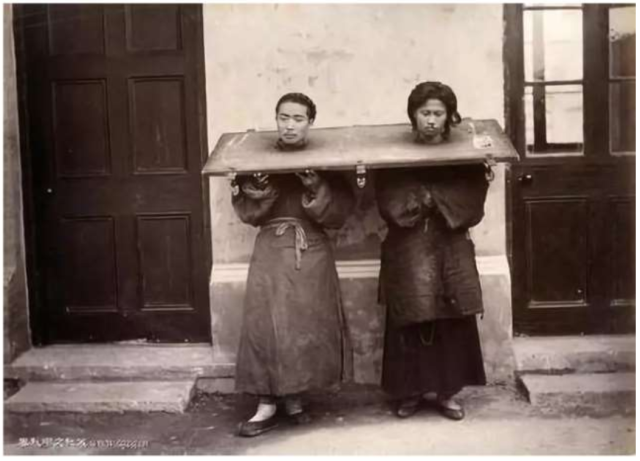Two shackled together in Hangzhou China. Picture taken by a French photograph of Yang Naiwu and little Chinese cabbage 楊乃武 小白菜 who were involved in a famous murder case.
Yang Naiwu and little Chinese cabbage 楊乃武 小白菜 were involved in a famous murder case in the Qing dynasty. "little Chinese cabbage" was the nickname for the woman involved as she liked to dress in white jacket and green pants. Little cabbage and her husband rented a unit in Yang's house. The husband worked in a tofu shop. Yang's family and Little cabbage became close as Yang taught her to read and write. One day the husband died suddenly with blood coming out of his nose and mouth. It happened the local magistrate Lau held a grudge against Yang who previouly had filed a complaint against him. Therefore Lau decided to frame Little cabbage as the murderer and Yang as conspirator. He decided the two were involved in a extra marital affair. It resulted in a verdict of death. Luckily Yang had connections. This case got the attention of Empress Dowager who ordered a retrial.
The 1876 picture here was taken by a French photographer at a temple where the coffin was opened and the body examined. They found the cause of death was a disease instead of poison. Lau and other higher officials who previously tried this case lost their jobs as a result. Here the shackle is around the neck instead of around the ankles which seems to be more common in Hong Kong.

Comments
Research about photography
Picture taken by William Thomas Saunders (1832–1892), who was a British-born photographer who settled in China and became the leading photographer in Shanghai during the late Qing dynasty.
Sources : 1) https://www.hpcbristol.sjtu.edu.cn/visual/os04-017 2) research by Régine Thiriez
sourse
Apparently the picture was provided by a Chinese historian. He got the picture and a written description from the daughter of Yang Naiwu in 1963. The picture was taken at a temple in Hangzhou called 海会寺. I guess the location was not that difficult to verify for local residents of the city.
https://kknews.cc/history/y55qblg.html
https://www.sohu.com/a/402793563_617484
Re : Chinese historian (俞金生)
The news reported that this photo was supposedly from Yang's descendants in 2004, but this photo has appeared on postcards for a long time. Moreover, I cannot find any academic background about this Chinese historian (俞金生), do you know anything about him?
Not sure about the academic…
Not sure about the academic background of 俞金生. But his works are included in the following archive of the National Chekiang University China.
国立浙江大学历史文库
History of National Chekiang University
http://www.ncku1897.net/history/2018/05/25/1429/
As for the location where the coffin was opened, it was a temple called 海会寺Hangzhou China. In that archive, it seems there are official reports from the Qing dynasty which one can use to verify that location.